
HVAC Test - Journeyman practice exam test 3 of 4 Assessment
HVAC Test - Journeyman practice exam test 3 of 4 :
Online HVAC test and journeyman practice exam 3 of 4. 21 questions in this practice exam. Plus, advice on How to test the HVAC blower motor with a multimeter.
Please consider our training while here ...
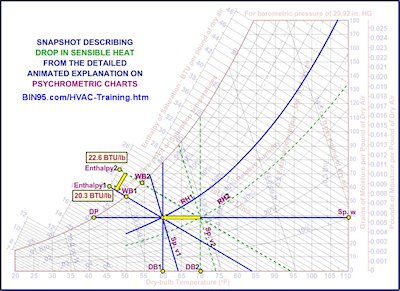
Study up with our Commercial & Industrial Refrigeration Training Course. A great start for HVAC Technicians.
HVAC Test - Journeyman practice exam test 3 of 4 test details:
( 21 Questions )
Online HVAC practice test with questions and answers. 3 of 4 HVAC tests, with 87 questions total. 21 questions in this test.
If you found this test via a search, please see the advice below about How to test the HVAC blower motor with a multimeter. This extra information may help get your thoughts on the job before taking the test above—just some basics.
How to test the HVAC blower motor with a multimeter
1. Identify the type of HVAC blower motor you have.
2. Check the blower motor voltage.
3. Unwire the motor (maybe the capacitor too).
4. Measure the resistance of the motor winding.
To test the HVAC blower motor with a multimeter, you can follow these steps:
Step 1: What type of HVAC blower motor do you have?
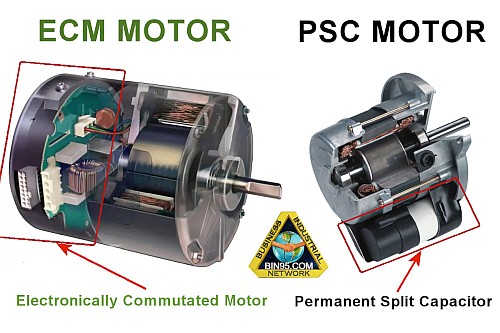
Visually identify what type of HVAC blower motor you have.
There are two types of HVAC blower motors:
- ECM (Electronically Commutated Motor) is a variable-speed motor with 95% efficiency. They are a DC motor with a built-in inverter and a magnet rotor. So, they typically do not have an external VFD, though they can (DC Motor).
- PSC (Permanent Split Capacitor) runs at a constant speed. It is an AC motor that costs more to run and is usually found in older HVAC units.
Nowadays, most are energy-efficient ECM motors. However, we need to determine the voltage of the blower motor. It could be 12-24v for a car air conditioner. An ECM blower motor is a brushless DC motor, so it could also be a 12-24V motor used in modern car air conditioners. Older cars and buildings use brushed DC motors or PSC motors.
Or you may be dealing with a 120v for a residential home air conditioner or 480v for a commercial HVAC unit. Either PCS or ECM for building HVAC.
ECM has spaded connectors for both motor power and control signals. A capacitor attached to the side of the electric motor is a giveaway that it is a PCS motor.
Those new to the industry may wonder how AC powers an ECM brushless DC blower motor. It has a built-in inverter that converts the power to DC.
Step 2: How to check blower motor voltage?
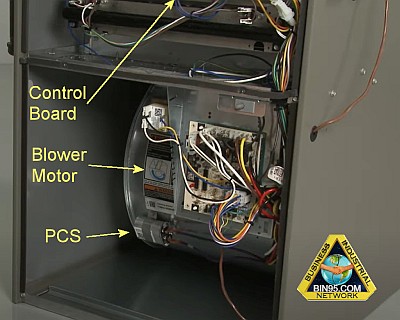
Where is the blower motor on a furnace? Control board? Capacitor?
To check the blower motor voltage, you can follow these steps:
- POWER DOWN
- Check the blower motor's nameplate voltage. It's usually in the lower half of the unit for buildings. In an automotive air conditioning system, access will be much more difficult. Check for signs of failure while viewing the motor nameplate, like a burnt area or a disconnected wire.
- Refer to the unit's circuit diagram to identify the correct wires.
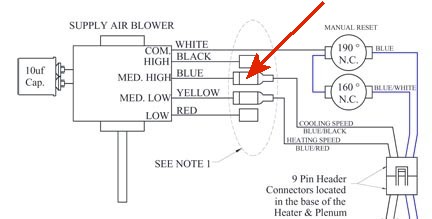
- Locate the blower motor power in wires on the control board, typically in the unit's upper half.
- While the power is off, remove the control board output wires that go to the blower motor. The three wires may be red, blue, and black. They are usually thicker than the other wires on the control board's spaded connector.
- Adjust the thermostat so it calls for the blower motor to run.
- Use your volt meter on the proper setting to verify the correct voltage output from the control board.
- If the correct voltage is present, test the Run capacitor. The blower motor or wire is faulty if the run capacitor is good.
Step 3: Unwire the motor (maybe the capacitor too).
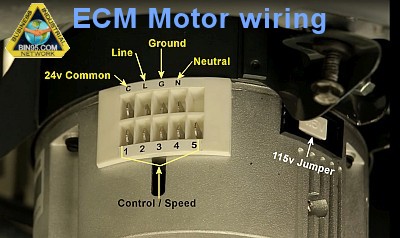
Unwire the blower motor before measuring resistance. Verify the power is off first. If it is a PCS motor, unwire the capacitor too.
If it's an ECM motor, you may need to remove the inverter from the back of the motor to access the windings.
Step 4: Measure the resistance of the motor windings.
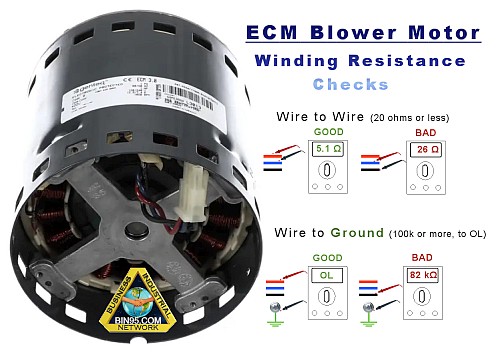
Check resistance from wire to wire and each to ground.
You should see a specific resistance value when measuring the blower motor windings with a volt meter. To test the blower motor windings in general, follow these steps:
- Power should be off and completed before unwiring in the previous step.
- Set the multimeter to the resistance or ohm setting.
- Locate the motor winding terminals. These are the wire connections on the motor where the windings are attached. (For the ECM motor, remove the back control section. It reveals a three-pin terminal with red, blue, and black wires.)
- Place one of the meter's probes on one terminal and the second on the other motor terminal.
- Check the resistance reading on the meter. The value should be between 1 and 20 ohms. If the resistance reading is outside the range, it may indicate a problem with the motor windings.
You can assess the blower motor by measuring the resistance of its windings. This helps you troubleshoot any issues.
Step 5: Measure resistance to ground.
Set your meter to read resistance. The motor must be unwired from the circuit. The resistance from each motor wire to the ground should be infinite. (OL) At least no less than 100kΩ resistance.
Power Off First! Winding resistance no greater than 20 ohms. Wire to ground, 'OL' reading ideal.
Navigate below to one of the other three HVAC Test.
HVAC Test - Journeyman Practice Exam Test 1 of 4
HVAC Test - Journeyman Practice Exam Test 2 of 4
HVAC Test - Journeyman Practice Exam Test 3 of 4 << The page you are on now.
HVAC Test - Journeyman Practice Exam Test 4 of 4
Published:
